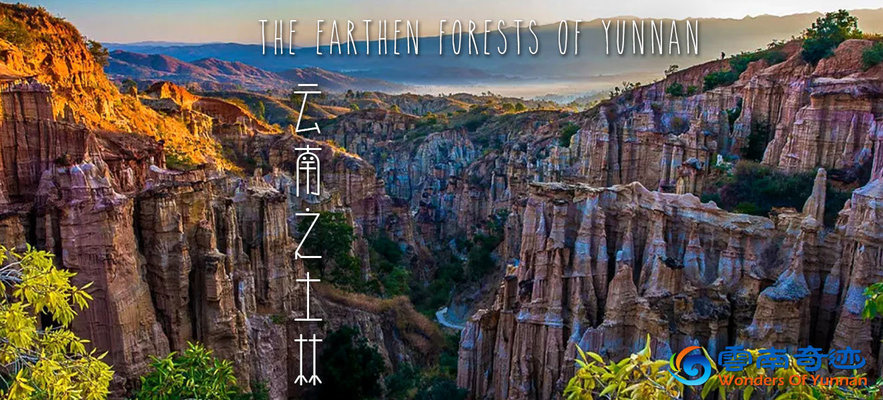Yunnan province has a lot of different landscapes, from the Himalayan highlands in the north to the tropical forests of Xishuangbanna in the south, and from volcanic canyons in the west to limestone karst in the east. About 94% of Yunnan is covered in mountains and half of Yunnan is covered in green forests.
But there are four forests that stand out. They’re not green, they are not made out of trees. They sprung from the earth itself. They are made of stone, earth, sand and plaster. They are – you never would’ve guessed – the Stone Forest, the Earth Forest, the Sand Forest and the Plaster Forest.
Most people have heard of the Stone Forest, an UNESCO heritage site which is part of the South China Karst, and a popular touristic spot next to Kunming. But have you heard of the other three? And did you know there is also a Black Stone Forest?
The Shilin Stone Forest
Location: Kunming Prefecture, Shilin County
Chinese name: 石林风景区
Anyone diving into the beautiful world of travel in Yunnan must’ve heard of the Stone Forest, it is one of the most popular attractions in Yunnan province. As the name says, the Stone Forest is a forest made up of rocks, and if you visit the scenic area, you will immediately know why. Walking through the dense packed peaks and pinnacles that go up to 40 meters, feels truly like walking through a forest made of stone.
The rocks of the Stone Forest are made of limestone, and limestone consists mostly of skeletal fragments of marine animals, calcium carbonate. This makes limestone very soluble in water, and over millions of years, erosion by wind and water have shaped sharp stone spikes, sturdy stone pillars, stone bushes, aboveground stalagmites and karst caves, creating what can only be described as a stone forest.
The whole Stone Forest Scenic Area is about 400 square kilometers, and divided in different parks. The most popular one is the Lizijing Stone Forest (李子菁石林), which is divided in two parts, the Lesser Stone Forest and the Greater Stone Forest.
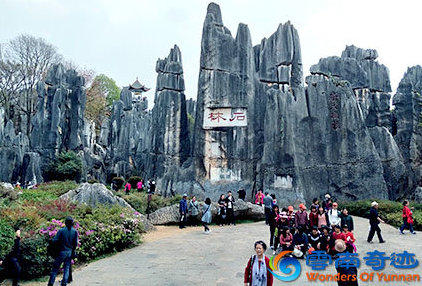
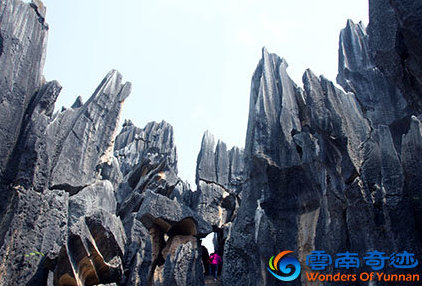 Left: entrance to the Great Stone Forest, one of the more crowded places of the stone forest. Right: walking and climbing through the forest, even in the touristic Great Stone Forest you will find secluded spots.
Left: entrance to the Great Stone Forest, one of the more crowded places of the stone forest. Right: walking and climbing through the forest, even in the touristic Great Stone Forest you will find secluded spots.
Lesser known, and thus also less crowded is the Black Stone Forest, also called Naigu Stone Forest (乃古石林). Only a 15-minute drive from the Lizijing Stone Forest it is really worth a visit if you want to avoid crowds. The rocks here have equally odd shapes as the other stone forest, with the only difference that they consist of black limestone, limestone combined with dolomite. The park has a lot wilder and less cultivated feel than the Lesser and Great Stone Forests, once you pass the planted fields of pink flowers that is.
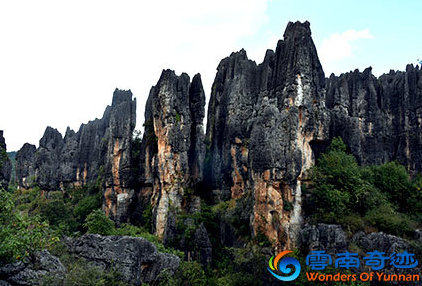
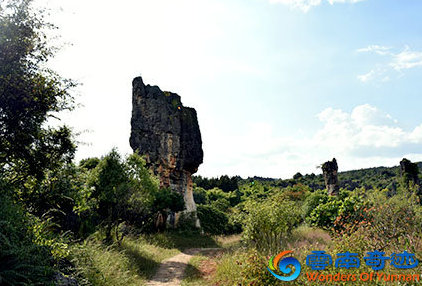 The Black Stone Forest is lesser known and you won’t see many others here. The landscape is less like a park, more like wild nature.
The Black Stone Forest is lesser known and you won’t see many others here. The landscape is less like a park, more like wild nature.
The Yuanmou Earth Forest
Location: Chuxiong Prefecture, Yuanmou County
Chinese name: 元谋土林
Not as famous as the Stone Forest, but equally beautiful, is the Earth Forest in Yuanmou County. The Earth Forest has an area of about 5 square kilometers. As most “earthen forests”, the landscape was shaped over millions of years of crustal movements by wind and water erosion. Where the Shilin Stone Forest rocks are made of limestone, the rocks of the Earth Forest are mostly made of clay.
The Earth Forest too has different parks, being Langbapu Earth Forest (浪巴铺土林), Wumao Earth Forest (物茂土林) and Banguo Earth Forest (班果土林). Wumao is the most easily accessible, but Langbapu is also popular.
There are four types of geological formations of clay pillars in the valley. The Earth Bud Formations are the smallest, often not bigger than 1 meter tall and 1 meter in diameter and made of sticky and semi-cemented clay. They can be called the “embryonic form” of the others, as they are formed by deposits of eroded water and soil that collects at the bottom of fractures in the earth. The Castle Formations are around 2 to 5 meters tall and made of both hard and soft clay rocks. They are connected at the bottom and with thick rounded tops, resembling a medieval castle.
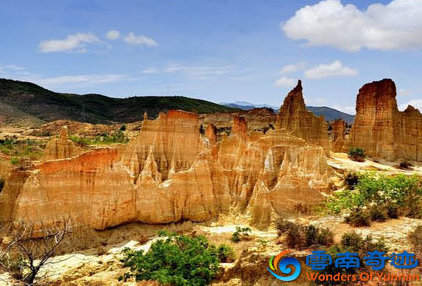
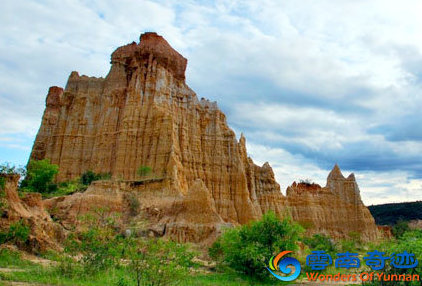 Left: the smallest Earth Bud formation. Right: the tall Castle formation
Left: the smallest Earth Bud formation. Right: the tall Castle formation
The Bamboo Shoot Formations consist of loose sand and clay with no solid rocks on the top, leaving most of the earth open to erosion. It created sharp spikes of earth, resembling bamboo shoots. The Mushroom or Iron Cap Formations are the most common. Because they are rich in iron, silica and calcium, on the top rainwater reacts with the soil, creating an iron-oxide, silica or calcium-iron cap that doesn’t erode like the lower part of the soil, creating mushroom shaped rocks.
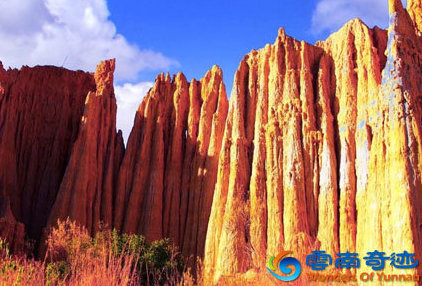
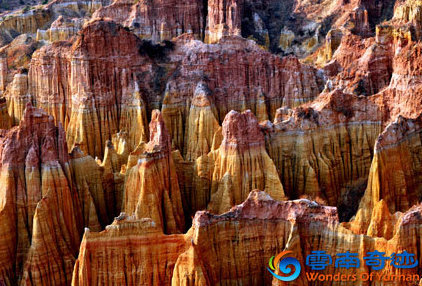 Left: easily recognizable is the Bamboo Shoot formation. Right: most rocks have the Iron Cap formation, also called the Mushroom formation
Left: easily recognizable is the Bamboo Shoot formation. Right: most rocks have the Iron Cap formation, also called the Mushroom formation
The Liulang Sand Forest
Location: Qujing Prefecture, Liulang County
Chinese name: 陆良彩色沙林
Covering an area of 25 square kilometre and having the shape of an Y, the Colourful Sand Forest is yet another earthy forest in Yunnan. The origin of the Sand forest is dated back 340 million years ago, but geological datings estimate that the formation of most colourful peaks started 65 million years ago, during tectonic movements of the Himalayan plate. Sandstone and magma’s containing different minerals were squeezed together, collided and permeated, creating a mix of different colors of sandstone. It was followed by rain, wind and sun erosion, which shaped the land into a forest made of sand.
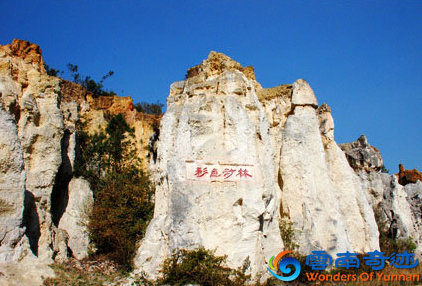
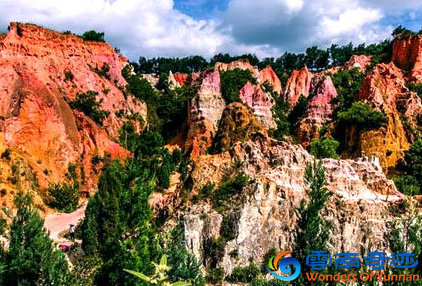 On bright and sunny days, the sands of the Liulang Sand Forest will be even more colourful.
On bright and sunny days, the sands of the Liulang Sand Forest will be even more colourful.
You can find sand peaks, sand pillars, san mountains sand screens, sand beaches and sand ditches, all showing layers of different colours. The main colors are golden yellow, white, red and grey, but you can also find black, green, blue and turquoise. In different seasons, weather conditions and viewing angles, you can see different, but all equally gorgeous and bright colors.
According to local myths, the Colorful Sand Forest was the incarnation of a black dragon. The black dragon was harmed by another dragon for saving the common people. The red sand is the flesh of the dragon, the white sand is the skin of the dragon, the black sand are the scales of the dragon, and the craggy cliff is the skeleton of the dragon. In order to commemorate the black dragon who died for justice, the people call this place black slope.
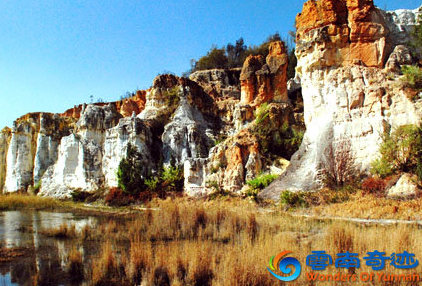
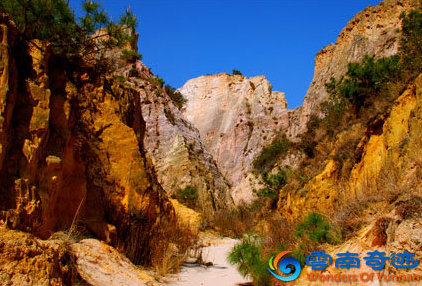 Most rocks in the Colourful Sand Forest are golden yellow or white.
Most rocks in the Colourful Sand Forest are golden yellow or white.
The Yuanjiang Plaster Forest
Location: Yuxi Prefecture, Yuanjiang County
Chinese name: 元江彩色膏林
The last of the Earthen Forests of Yunnan, is the Colourful Plaster Forest in Yuxi’s Yuanjiang. It is a small but unique piece of land-forest, only 0.5 square kilometers big. For thousands of years, the locals knew of the place and thought it beautiful, but didn’t pay much attention to it. They called it the Earth Forest.
The name was officially made Plaster Forest in 2002 (possibly because Yunnan already has another Earth Forest) because the peaks are composed of salt rock containing gypsum, also known as plaster and with the chemical name calcium sulfate dihydrate (CaSO₄·2H₂O). Because the rocks have different minerals and chemical components, the peak clusters have different colour shade, such as gray and green, gray and purple, gray and red, and yellow and brown.
Yuanjiang's Plaster Forest is very distinctive, quite different from the Stone Forest, Earth Forest and Sand Forest. The color paste forest is rich in colors you don’t see anywhere else. According to geologists, there is no other plaster forest of this scale in the world. It is a very rare unique geological wonder and geological heritage, with great value of geological research and of course also makes a very rare tourist attraction.
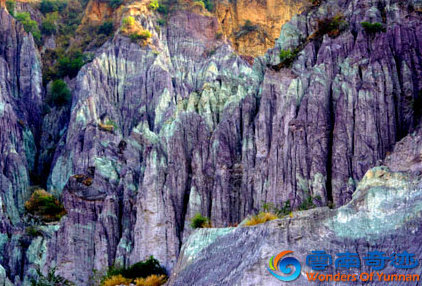
 Due to the different minerals and chemical components, the rocks in the Plaster Forest have a purple hue.
Due to the different minerals and chemical components, the rocks in the Plaster Forest have a purple hue.
Most of the columns are tapered, thick at the bottom and sharp at the top, with a height of 40 to 50 meters or more. Some of the peaks on the gentle slope can reach 100 meters. The colors and the column shapes are changeable, forming soft, harmonious, elegant, beautiful and rich rocks, almost like a poetic painting.
Close to the Plaster Forest, you will see a large area, that when the sun shines, has a colorful halo of different spectacular peaks. Under influence of long-term wind and rain, the minerals such as the gypsum on the surface of the pillars will change chemically and form a protective film layer, which makes the earthen pillars in this area have a certain anti weathering ability, so it is naturally a preserved gypsum forest.
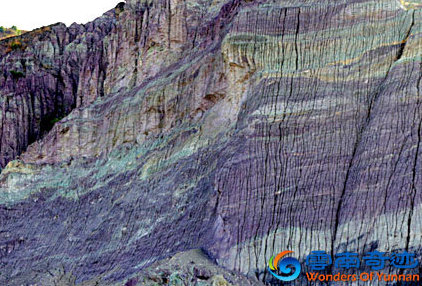
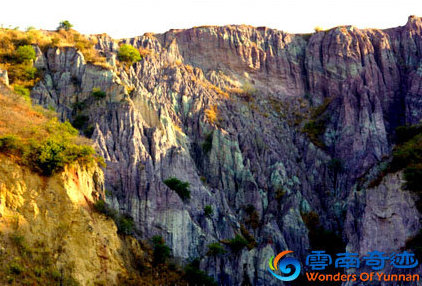 The Plaster Forest is a small, but rare and spectacular earthen forest.
The Plaster Forest is a small, but rare and spectacular earthen forest.
- 355 reads
- Like this






